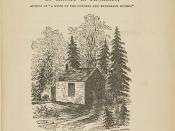"There us a moment in the history of every nation when, proceeding out of this brute youth, the perceptive powers reach their ripeness and have not yet become microscopic; so that man, at this instant, extends across the entire scale." (Emerson 180) During the time in which Emerson stated this opinion, a new philosophy or idea was introduced in American literature. The idea, Transcendentalism, focuses mainly on individualism, goodness in nature and humanity, and what is known as an "oversoul". However, for every new philosophy, there is an opposing philosophy created. Anti-Transcendentalism focuses on the idea that people are born sinful and recognizes the existence of evil. The two philosophies, Transcendentalism and Anti-Transcendentalism, contrast greatly in their views of humanity, their aspects of nature, and their concepts of good and evil. The authors that include these ideas in their writing use themes to differentiate between beliefs. Some of the authors noted for their support of transcendentalism are Emerson and Thoreau.
The most recognized ant-transcendentalism writers are Hawthorne and Melville. All of these writers may contrast in their beliefs; however each studies the world around them to form their philosophies.
To begin with, in The Scarlet Letter, written by Hawthorne, the main characters Hester and Dimmesdale are used to represent the anti-transcendentalism views of humanity. Hester represents the concept of original sin. The concept of original sin is that man is born sinful into a god ordered world. Hester, though she is not at all a bad person, commits a sin that condemned her for life. The Puritan society that she lives in demands perfection and her sin costs her a life of solitude and loneliness. Also, Hawthorne uses Dimmesdale to prove that sin and guilt is a large part of human life. Dimmesdale faces no consequences publicly for his...


